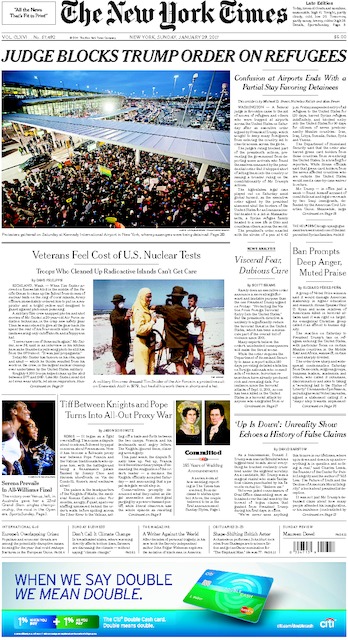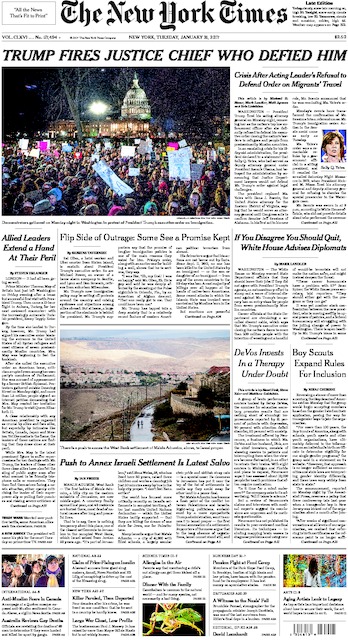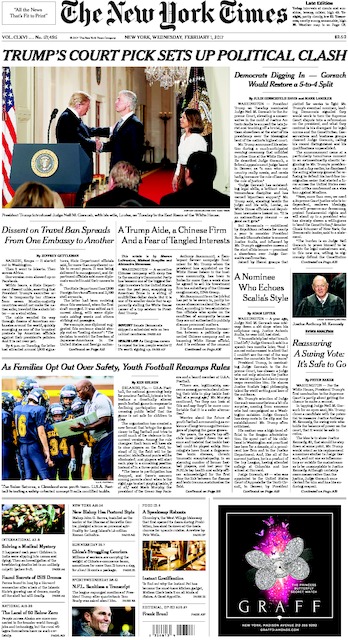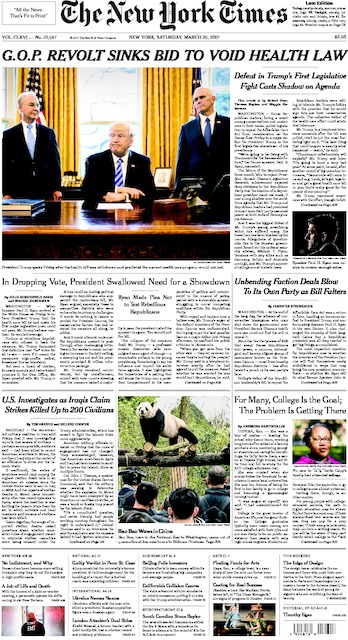Sign up for The Media Today, CJR’s daily newsletter.
Two hundred and twenty-two stories. One hundred and one headlines. Thirty-five pictures. That’s what Donald Trump has meant to The New York Times’s front page in the first 100 days of his presidency.
Much has been made of Trump’s ability to drive the news cycle, but how does coverage of the 45th president compare to that given to the two men who held the office before him? A study of Times front pages from the first hundred days of the Bush, Obama, and Trump presidencies shows that the number of stories about Trump far exceeds those devoted to his immediate predecessors.
Number of times front-page stories were published about Bush, Obama, and Trump during their first 100 days in office
Times Deputy Managing Editor Matt Purdy says the combination of Trump’s unique personality, contentious policies, and public interest in his administration have contributed to the increased number of stories deemed worthy of A1. “We’re living through one of the most extraordinary news environments since 9/11,” Purdy says. “The firehose of news has not shut off for a moment.” That deluge of news is reflected in a recent piece on the Times’s website that gives context through headlines to the news Trump, Obama, and Bush woke up to on each of their first 100 days in office.
RELATED: 11 images that show how the Trump administration is failing at photography
A note on CJR’s methodology: While some stories clearly focused on the respective chief executives, the criteria that led to us to define a story as “about” one of the presidents were somewhat subjective. For example, we counted a piece about the Bush administration’s tone in negotiations with China over a spy plane incident in April 2001 as a story about the 43rd president. Likewise, stories about Obama’s war plans or Trump’s travel ban that mentioned each president several times were included in the tally, while pieces that mentioned the president but largely focused on other topics weren’t.
The 100 days trope dates to the near-depth of the Great Depression, when a newly inaugurated Franklin D. Roosevelt used his first 100 days to dramatically reshape the American economy. The 13 presidents since have tried, with varying degrees of futility, to live up to Roosevelt’s standard.
The Obama White House referred to the 100-day milestone as a “Hallmark Holiday,” and Trump himself called it “an artificial barrier.” While both those arguments have merit, news organizations and the current administration love nothing more than an opportunity to draw eyeballs to their work. To that end, you can watch CNN’s mini-documentary “100 Days that Changed America,” peruse NBC News’s 14-story package on “Trump’s First 100 Days,” take a deep dive into The Washington Post’s look at the period “In his words and ours,” or even join the man himself for a “BIG rally” in Pennsylvania on Saturday.
It’s not just within Times articles that Trump has outpaced Bush and Obama. His name has appeared in headlines significantly more often than either of the previous presidents, and he has been pictured on A1 nearly twice as often.
Number of times the past three presidents’ names were used in front-page headlines during their first 100 days in office
Number of times the past three presidents were pictured on the front-page during their first 100 days in office
RELATED: Donald Trump killed the news cycle
Trump is also an outlier in the way the Times has presented stories about his most contentious actions. The travel ban, the firing of acting attorney general Sally Yates, and the failed attempt to repeal Obamacare have all resulted in full-page headlines—one way the paper signals an especially notable event. All three presidents rated six-column headlines for their inauguration, but Bush didn’t see another one during his first 100 days. Obama, meanwhile, got the full-spread treatment for his budget proposal and a five-column header for his first address to congress. With Trump, the Times has been far more liberal with the bold type, giving him five full-page headlines as well as three additional five-column spreads. Purdy pushes back against the idea that the increase in blaring headers represents alarmism. “These [headlines] are simply driven by significant news events,” he tells CJR.
The “paper of record” has also given prime real estate to figures surrounding President Trump. The appointment of Neil Gorsuch to the Supreme Court and the controversy surrounding former National Security Advisor Michael Flynn accounted for some of the bump in the number of stories about Trump’s advisors, but Chief Strategist Steve Bannon and Special Advisor Kellyanne Conway also got the A1 treatment. Aides and advisors to previous presidents received far less attention.
Number of times the past three presidents’ aides and cabinet members were written about on the front page during the administration’s first 100 days in office
Overall, stories about Trump, his aides, advisors, and cabinet picks dominated the most valuable real estate in print media far more than previous 21st-century presidents. Essentially half of the Times’s A1 stories have been devoted to coverage of Trump and the circle of people surrounding him. With the official end of his first 100 days coming on Saturday, this weekend’s front pages will undoubtedly bring more of the same.
Percentage of total front-page stories
Disclosure: Kate Kelly, one of the New York Times reporters whose work is included in these graphics, is married to CJR Editor in Chief and Publisher Kyle Pope.
TRENDING: Stop killing your social stories with bad headlines and images
Has America ever needed a media defender more than now? Help us by joining CJR today.







